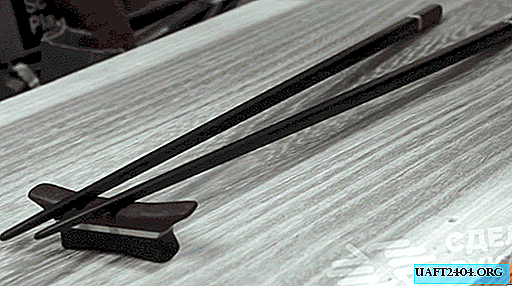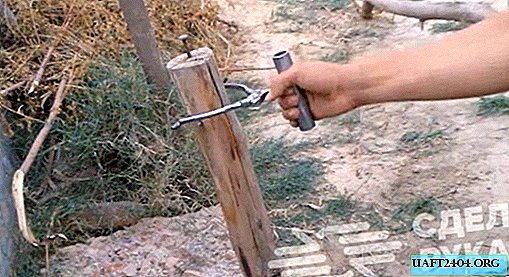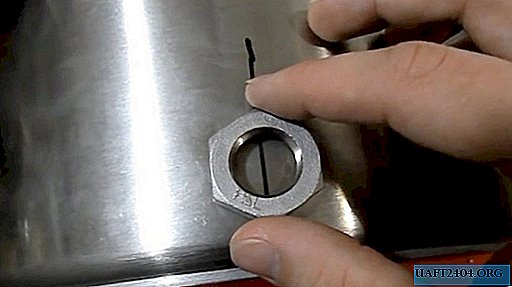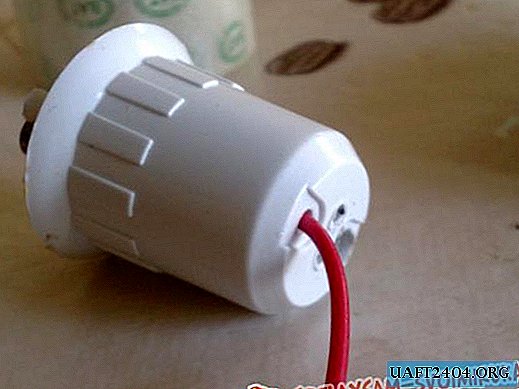Share
Pin
Tweet
Send
Share
Send
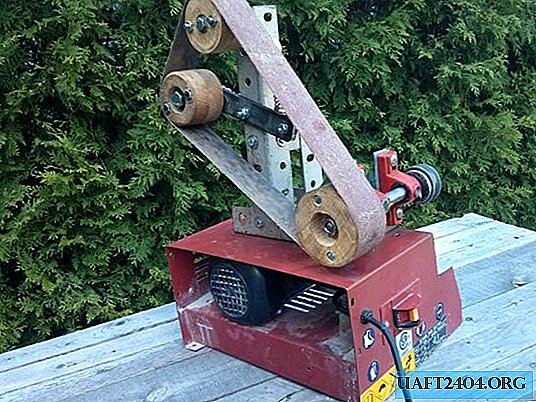



I have been manufacturing knives for several years, and I always use 2.5 x 60 cm and 10 x 90 cm belt grinders in my business. For a long time I wanted to buy another one, with a tape width of 5 cm, as this would simplify my work. Since such a purchase would be an invoice, I decided to make it myself.
Problems in designing the future machine:
Three limitations had to be overcome. Firstly, there was no 10 cm wide tape in the place; it could only be ordered on the Internet. For me, this option did not seem very acceptable, since there is no greater disappointment than finding that the tape is worn out and needs to be replaced, and you have to wait a week or two until a new one arrives. Secondly, there was a problem with the videos. I searched, but could not find suitable ribbons for 10 cm. Thirdly, the motor. For a belt sander, a fairly powerful electric motor is needed, and I did not want to spend too much on this project. The best option for me was to use a used motor.
Solutions to design problems:
The first problem with the tape found a simple solution. Since the belt 20 x 90 cm was available for sale in construction stores at a reasonable price, I could make two 10 cm out of it. This imposed restrictions on the size of my machine, but because of the cost effectiveness, this option was the best. The second problem was solved using a lathe. To do this, I watched a video on the Internet, and realized that I myself could make the videos I needed. With a motor, the task was more complicated. In the garage I had several electric motors, but for some reason I had to abandon them. Finally, I opted for an old tile cutting machine in which a 6-amp electric motor was installed. At that time, I realized that this power may not be enough. But since the work was at the stage of the experiment, I decided to first achieve a working version of the machine, and the motor can be replaced later. In fact, the motor is suitable for a small amount of work. But if you are going to produce more intensive grinding on it, I would recommend a 12-amp minimum.
In the end, it was interesting to experiment. And I thought it would be useful to share a knife making machine, without spending a lot of money.
Tools and materials





Instruments:
- Angle grinder with cutting discs.
- Drill and drill.
- Wrenches 11, 12 and 19.
- Lathe.
- Vise.
Materials:
- Electric motor (minimum 6 A, or recommended at 12 A).
- Various bearings.
- Nuts, bolts, washers, lock washers of various sizes.
- Metal corner.
- Sanding belt 20 cm.
- 10 cm pulleys.
- Powerful spring.
- Steel strip 4 x 20 cm.
- Bar 2.5 x 10 x 10 cm from wood or MDF.
Electric motor for the machine






I had a choice of several motors, but the electric motor that stood on the tile cutting machine had a more suitable casing. To some extent, work on the machine was like an experiment, because I was not sure about the sufficient power of the motor. Therefore, I settled on a modular solution with a frame for the belt mechanism as a single element, which can be removed and rearranged on a more powerful basis. The motor rotation speed was quite fine with me, but it worried that 6 A would give weak power. After a little test, I saw that this motor was suitable for simple operation, but for more intensive work, you need to choose something more powerful. When designing your machine, pay attention to this moment.
As I mentioned, the casing of the electric motor was very suitable, as it allowed to create a vertical machine that would be easy to move.
First you need to free it by removing the desktop, saw, protection, water pan, leaving only the electric motor. Another advantage of using this motor was a core with a thread and a nut for fixing the saw, which made it possible to install a pulley without using a key (what a key is, I will explain later).
Since I had a pulley that was too wide, I decided to use large clamping washers, which usually fix the saw, turning one side upside down so that there is a wedge-shaped groove between them. I found that the space between them is too narrow, and in order to expand it, I put a lock washer between them. The advantage in this method is that the pressure washers have a flat edge that is fixed with a flat edge for simultaneous rotation with the core.
Belt
The drive belt I used was 7 x 500 mm. You can use the standard 12 mm, but the thin one is more flexible and it will load the motor less. He does not need to rotate the grinding wheel.
Belt Sander Device

The device is simple. The electric motor drives a belt that rotates the “main” pulley 10 x 5 cm, which drives the abrasive belt. Another 8 x 5 cm pulley is located 40 cm above the main one and 15 cm behind it and is mounted on a bearing. The third 8 x 5 cm pulley rotates on the lever, and acts as a tension roller, tightly holding the abrasive belt. On the other side, the lever is spring-loaded to the frame.
Drive Type Definition
The main issue was to rotate the main pulley directly with an electric motor or with the help of an additional pulley and drive belt. First of all, I chose a belt drive because I wanted to have the opportunity to replace the engine with a more powerful one, however, there was another reason. When you perform heavy metal processing, there is a risk of encountering some problems. Belt drive in such cases will slip, while direct drive will create big problems. With a strap, the device will be safer.
Frame manufacturing and installation







It is important to mention that using a metal corner as a frame can have both advantages and disadvantages. The obvious advantage is that it is convenient to assemble, as a designer in childhood. But the main drawback is that it is strong in only two directions, but weak in twisting. So, you need to take into account this weakness and calculate what torque can be transmitted from the pulleys to the frame, and compensate for it with the help of additional jumpers.
Cutting:
You can use a hacksaw to cut a corner, but an angle grinder with a cutting disc will do the job faster. After all the elements have been cut off, I would recommend grinding all of their sharp edges so as not to cut themselves during assembly. The holes can be drilled using a conventional drill and cutting fluid.
Main movie







The main roller is the most important part of the project, as it receives torque from the motor and transfers it to the tape. I used an old bushing to mount it, but I recommend using a bearing instead. The bushings cope with their task, but they are constantly overheating and require regular lubrication. Moreover, they can scatter dirty grease, which is annoying during operation.
Shaft:
On the sides of the shaft there is a thread with a different direction so that during rotation the fixing bolts do not loosen. If you cut one side with a thread, as I did, leave the one that goes counterclockwise, otherwise you will have to make a lock bolt (I will describe how to do it later) and a cotter pin. The main pulley will be worn on the trimmed edge.
Pulley:
Continuing the topic of reuse, I found an old pulley from another project. Unfortunately, I prepared it for the threaded pin on which he had to hold, but, in fact, this is not a problem. I made a rectangular cutout in this pulley. Then, using an angle grinder, I cut a groove at the end of the shaft. Having placed the key in the hole formed by the groove of the shaft and the rectangular cut of the pulley, I firmly fixed them relative to each other.
Production of rollers for a grinding machine













I made rollers from several pieces of hardwood 2.5 cm thick. But you can use MDF, plywood or other material. When laying the layers, you need to make sure that the fibers are perpendicular, this will give the rollers additional strength and the layers will not crack.
It is necessary to make three rollers: the main roller, the upper roller and the tension roller. The main roller is made of two 13 x 13 cm pieces of 2.5 cm thick. The top and tension rollers of two pieces of wood measuring 10 x 10 cm.
Process:
Start by gluing pairs of 13 cm and 10 cm pieces of wood, clamping them with clamps. After the glue has dried, cut the corners with a miter saw, then find the center of each part. Fasten them in a lathe and process them until their sizes are 5 x 10 cm and 5 x 8 cm.
Top and idler rollers:
Next, it is necessary to install bearings in rollers measuring 5 x 8 cm. Choose a core or feather drill, and drill a recess in the center to the width of the bearing. The inner ring of the bearing should rotate freely, so you need to drill a hole that passes through the roller through the inner ring of the bearing. This will allow the bolt to go through with a minimum hole.
Main movie:
This part is done a little differently. There are no bearings on it, however, if the shaft leaves the roller less than 5 cm, it will be necessary to grind the roller in width. Measure the diameter of the shaft and in the center of the roller you need to drill the same hole. Try to insert the shaft, it should hold tight, otherwise the roller will shake.
Bolt Roller
Next, you should fasten the two halves of the rollers with bolts, do not rely only on glue. Remember that the bolt heads must be recessed in a tree, as the roller rotates in close proximity to the frame.
Tension lever






The lever is made of a metal strip measuring 10 x 30 x 200 mm with rounded edges. It is necessary to drill quite large holes in it, so I recommend using a drilling machine and a lot of grease for this. Just need 4 holes. The first is at the pivot point. It is not in the center of the plank, but 8 cm from its edge. The second hole will be on the edge closest to the pivot point. It will serve to attach the spring. Two additional holes must be drilled at the opposite end, approximately 5 cm apart. They should be slightly wider in diameter, as they will be used for tuning, which I will discuss later.
When all the holes are made, you can fix the shoulder on a vertical angle between the upper roller and the base. The end on which the spring will be attached is directed towards the main roller. It should rotate freely, so I recommend using two nuts for fastening, not twisting the main one completely, but using the second one as a lock nut.
Installing Rollers




The upper roller is fixed statically, and must be clearly in the same plane with the tensioner roller and the main roller. You can do everything by eye, but I recommend that you check everything well with a level. To align the roller, you can add a washer, or, if not enough, a bolt. They are inserted between the frame and the roller.
No need to fully install the tension roller. It is also necessary to make a stabilizing device.
Tape stabilization









Wear on the rollers or their uneven surface can lead to the fact that during operation the abrasive tape gradually comes off them. A stabilizing device is a device on a tension roller that allows it to be at an angle to ensure that the abrasive tape is held in the center. Its device is much simpler than it looks, and consists of a fixing bolt, a little free play of the tension roller and an adjusting bolt.
Drilling bolt holes:
For this purpose, I made a device in the form of a wedge-shaped cutout in the board, which will help to hold the bolt in place at the time of drilling. You can do this manually, but I do not recommend it.
Fixing bolt
A fixing bolt is a simple bolt with a hole drilled in it, and which is installed on the bar through a wide hole that is closer to the point of rotation of the lever. Since it is located between the lever and the roller, its head must be sharpened so that the roller does not catch it. The bolt must be secured as shown.
Bolt on which the roller is mounted
It needs to be slightly loosened so that the tension roller has a slight play. But to prevent it from spinning, you need to make a castellated nut. To do this, you just need to make incisions on the edges of a regular nut so that it looks like a crown. There will be two drilled holes in the bolt itself: one for the adjusting bolt, and it will be aligned with the hole of the fixing bolt, and the other for fixing the castellated nut with a cotter pin.
Bolt to adjust:
After the tension roller is put in place, you can install the adjusting bolt, which will pass through the holes of the fixing bolt and the bolt on which the tension roller rotates. The system works when you tighten the adjustment bolt, forcing the axis of rotation of the tension roller to shift the angle of rotation outward, thus forcing the tape tends closer to the mechanism. A spring at the other end of the lever adjusts the tension in the opposite direction. I recommend securing the adjusting bolt with a lock nut, as vibration can loosen it.
Note: You can add a spring on the back of the tension roller, but I have not found a reason why this is worth doing. A small advantage will be that in this way the roller will have less play. But I will add that I did not do this, and I did not have any problems.
DIY completion of the machine






When everything is done, you need to once again check all the bolts, and make sure that the stabilization mechanism is assembled correctly. Then you need to turn on the device for the first time, which can be scary. It’s as if you are driving a car where the steering wheel and transmission do not work. I recommend turning the motor on and off for a very short time so that the machine does not rotate at full power.
In fact, for me, the hardest part was setting up the spring. If it pulls too much, then the tape will not be able to rotate ... Too weakly - and it is impossible to hold it, it flies, which is dangerous in itself.
Done!



That's all. You should get a decent belt grinder of medium power, which, if desired, can be converted into a more powerful one.
I hope you enjoyed this workshop. Thanks for your attention.
Original article in English
Share
Pin
Tweet
Send
Share
Send

